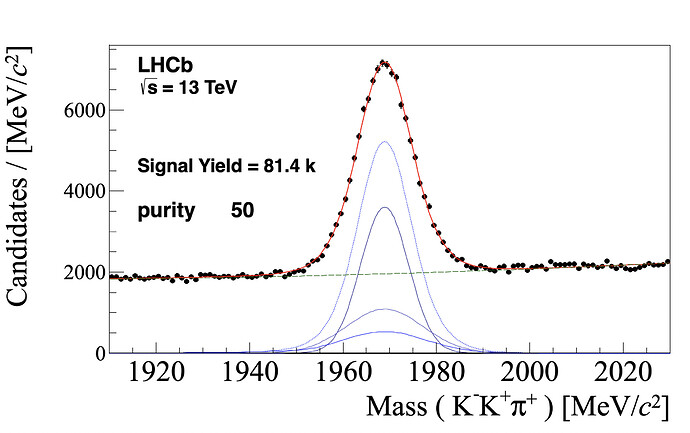Dear experts,
I perform a fit to an invariant mass distribution with a model composed by a signal and a background pdf with RooFit using ROOT 6.22/06. Now I’m trying to get the uncertainties for the signal and the background components in different sub-ranges of the fitted spectrum.
I’ve tried to do this by two different methods:
1. with RooFit createIntegral (as in this post)
In this case, I compute the integral for a given pdf component in a given range as
RooAbsReal* i_sig = epdf_Sig->createIntegral(*mass, NormSet(*mass), RooFit::Range("signalRange"));
and compute the yield and uncertainty as
Double_t NsigSigWin= Nsig*i_sig->getVal();
Double_t dNsigSigWin= Nsig*i_sig->getPropagatedError(*fit,*mass);
for the signal region, I get
Method 1: Fractions in sig region => sig= 0.980527 +- 0.000345
Method 1: Fractions in sig region => bkg= 0.330025 +- 0.001270
Method 1: Fractions in sig region => tot= 0.495956 +- 0.001029
Method 1: Nsig in signal region = 79827.512086 +- 28.076938
Method 1: Nbkg in signal region = 78467.443825 +- 301.952905
Method 1: Ntot in signal region = 158299.297326 +- 328.509493
Here the uncertainty for the signal yield (Nsig) don’t seem to make much sense, while for the background (Nbkg) it seems reasonable.
2. converting to a TF1 and using IntegralError (as in here and here)
For this I get the parameters list related to the pdf component, make a TF1 from this component and compute the IntegralError using the reduced covariance matrix with the varying parameters for that component, as in
RooArgList pars_sig(*N_Sig, *m, *Sigma_G1);
RooArgSet prodSet_sig(*epdf_Sig);
RooProduct unNormPdf_sig("fitted Function Sig", "fitted Function", prodSet_sig);
TF1 * f2_sig = unNormPdf_sig.asTF(RooArgList(*mass), pars_sig);
double nsig = ((RooRealVar*) pars_sig.find("N_{sig}"))->getVal();
Double_t fSig_full = f2_sig->Integral(massLo, massHi);
Double_t dnsig_full = nsig*f2_sig->IntegralError(massLo, massHi, 0, fit->reducedCovarianceMatrix(pars_sig).GetMatrixArray())/fSig_full;
Double_t fSig_sigreg = f2_sig->Integral(massSigLo, massSigHi, 0)/fSig_full;
Double_t nsig_sigreg = nsig*f2_sig->Integral(massSigLo, massSigHi, 0)/fSig_full;
Double_t dnsig_sigreg = nsig*f2_sig->IntegralError(massSigLo, massSigHi, 0, fit->reducedCovarianceMatrix(pars_sig).GetMatrixArray())/fSig_full;
In this case, I get
Method 2: Fractions in sig region => sig= 0.973391
Method 2: Fractions in sig region => bkg= 0.330023
Method 2: Nsig in signal region = 79250.588504 +- 497.202333
Method 2: Nbkg in signal region = 78467.443825 +- 26045.335944
Now the uncertainty for the signal yield make much more sense, but the one for the background doesn’t.
As a “cross-check”, I’ve tried to compute the yields w/ uncertainties in the whole mass spectrum to compare with the fitted yields.
For method 1, I get
Method 1: Fractions in whole spectrum => sig= 1.000000 +- 0.000000
Method 1: Fractions in whole spectrum => bkg= 1.000000 +- 0.000000
Method 1: Fractions in whole spectrum => tot= 1.000000 +- 0.000000
Method 1: Nsig in whole spectrum = 81416.989289 +- 0.000000
Method 1: Nbkg in whole spectrum = 237763.211200 +- 0.000000
Method 1: Ntot in whole spectrum = 319180.200489 +- 0.000000
And for the method 2:
Method 2: Nsig in whole spectrum = 81416.989289 +- 548.049714
Method 2: Nbkg in whole spectrum = 237763.211200 +- 78893.342729
while the fitted yields are
Fitted yield: Nsig = 81416.989289 +- 547.600470 (getPropagatedError); NsigError = 547.599057 (getError)
Fitted yield: Nbkg = 237763.211200 +- 675.409048 (getPropagatedError); NbkgError = 675.406395 (getError)
The method 2 uncertainty for the signal yield is very close to the fitted one, but the background yield uncertainty is much larger.
So, why do both methods give different results?
Why the method 2 seems to almost reproduce the uncertainty from the fitted signal yield for the whole spectrum, but not for the background? And why it is still slightly different?
And, more generally, how to correctly compute the uncertainties for pdf components in a given sub-range?
A short running example with the whole code and a rootfile is attached in case you want to reproduce this problem.
Thanks in advance!
Cheers,
FitG2CB_simple.C (22.6 KB)
histofile.root (3.9 KB)
